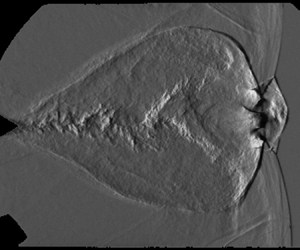Published online by Cambridge University Press: 07 December 2020

Shock reflection experiments are performed to study the large-scale convective mixing created by the forward jetting phenomenon. Experiments are performed at a wedge angle of  $\theta _{{w}} = 30^{\circ }$ in nitrogen, propane–oxygen and hexane with incident shock Mach numbers up to
$\theta _{{w}} = 30^{\circ }$ in nitrogen, propane–oxygen and hexane with incident shock Mach numbers up to  $M = 4$. Experiments are complemented by shock-resolved viscous simulations of triple-point reflection in hexane for
$M = 4$. Experiments are complemented by shock-resolved viscous simulations of triple-point reflection in hexane for  $M = 2.5$ to
$M = 2.5$ to  $6$. Inviscid simulations are performed over a wider range of parameters. Reynolds numbers up to
$6$. Inviscid simulations are performed over a wider range of parameters. Reynolds numbers up to  $Re \lesssim 10^3$ are covered by simulations and Reynolds numbers of
$Re \lesssim 10^3$ are covered by simulations and Reynolds numbers of  $Re \sim 10^5$ are covered by experiments. The study shows that as the isentropic exponent is lowered, and as the Mach number and Reynolds number are increased, the forward jet approaches the Mach stem, forms a vortex, deforms the shock front and in some cases bifurcates the Mach stem. Experiments show that Kelvin–Helmholtz instabilities in the vortex cause large-scale convective mixing behind the Mach stem at low isentropic exponents (
$Re \sim 10^5$ are covered by experiments. The study shows that as the isentropic exponent is lowered, and as the Mach number and Reynolds number are increased, the forward jet approaches the Mach stem, forms a vortex, deforms the shock front and in some cases bifurcates the Mach stem. Experiments show that Kelvin–Helmholtz instabilities in the vortex cause large-scale convective mixing behind the Mach stem at low isentropic exponents ( $\gamma \le 1.15$). The limits of Mach stem bifurcation (triple Mach–White reflection) in inviscid simulations are plotted in the phase space of
$\gamma \le 1.15$). The limits of Mach stem bifurcation (triple Mach–White reflection) in inviscid simulations are plotted in the phase space of  $M$–
$M$– $\theta _{{w}}$–
$\theta _{{w}}$– $\gamma$. A maximum isentropic exponent of
$\gamma$. A maximum isentropic exponent of  $\gamma \approx 1.3$ is found beyond which bifurcation does not occur (at
$\gamma \approx 1.3$ is found beyond which bifurcation does not occur (at  $\theta _{{w}} = 30^{\circ }$). This closely matches the boundary between irregular and regular detonation cellular structures.
$\theta _{{w}} = 30^{\circ }$). This closely matches the boundary between irregular and regular detonation cellular structures.
Present address: Department of Chemistry and Chemical Engineering, Royal Military College, 11 Crerar Crescent, Kingston, Ontario K7K 7B4, Canada.
Schlieren video experiment 1 (nitrogen, $M_{\mathrm{c}}=2.4$, $\gamma_0 = 1.4$, $\theta_{\mathrm{w}} = 30^{\circ}$)
Schlieren video experiment 2 (nitrogen, $M_{\mathrm{c}}=3.0$, $\gamma_0 = 1.4$, $\theta_{\mathrm{w}} = 30^{\circ}$)
Schlieren video experiment 4 (propane-oxygen, $M_{\mathrm{c}}=2.4$, $\gamma_0 = 1.15$, $\theta_{\mathrm{w}} = 30^{\circ}$)
Schlieren video experiment 5 (propane-oxygen, $M_{\mathrm{c}}=2.9$, $\gamma_0 = 1.15$, $\theta_{\mathrm{w}} = 30^{\circ}$)
Schlieren video experiment 6 (propane-oxygen, $M_{\mathrm{c}}=3.5$, $\gamma_0 = 1.15$, $\theta_{\mathrm{w}} = 30^{\circ}$)
Schlieren video experiment 7 (hexane, $M_{\mathrm{c}}=2.5$, $\gamma_0 = 1.06$, $\theta_{\mathrm{w}} = 30^{\circ}$)
Schlieren video experiment 8 (hexane, $M_{\mathrm{c}}=2.7$, $\gamma_0 = 1.06$, $\theta_{\mathrm{w}} = 30^{\circ}$)
Schlieren video experiment 9 (hexane, $M_{\mathrm{c}}=3.4$, $\gamma_0 = 1.06$, $\theta_{\mathrm{w}} = 30^{\circ}$)